Translate this page into:
Skeletal Class II Case Presentation: Utilization of the AdvanSync 2 Appliance
This article was originally published by Wolters Kluwer and was migrated to Scientific Scholar after the change of Publisher.
Abstract
The Herbst appliance has been used routinely in the specialty of orthodontics for nearly 40 years. Over this time, many design variations have been utilized. One of the recent designs is the AdvanSync 2 appliance, manufactured by Ormco. The AdvanSync 2 appliance is smaller than the conventional Herbst appliances and allows the clinician to place braces on all the permanent teeth forward of the first molars. In the case presented, the patient presented with a skeletal Class II, division 2 malocclusion. Facially, it was determined that mandibular advancement would be advantageous for ideal facial esthetics. The result of treatment utilizing the Damon System braces and the AdvanSync 2 Class II corrector was an excellent outcome both dentally and in regard to facial esthetics.
Keywords
AdvanSync 2
herbst
non surgical
orthopedic correction
skeletal class ii

[SHOW_RELATED_PUBMED_ARTICLES]
My father, Terry Dischinger, was a pioneer in the treatment of Class II patients in orthodontics. In the early 1980s, he was fascinated by the research being published by Dr. James McNamara, showing condylar growth in rhesus monkeys.[1,2] When fixed Class II correctors were introduced by Dr. Hans Pancherz, my father decided that was the path he wanted to pursue in treating his skeletal Class II patients.[3,4] Over the following years, he participated in many research projects, resulting in a number of published articles comparing removable versus fixed appliances as well as various fixed appliances to one another.[5-7]
In 2008, my father and I set out to design a new Herbst appliance. Our main goal was to improve the comfort of orthopedic Class II treatment for our patients. The result was the development with Ormco of the AdvanSync appliance, followed by a couple of years later with the AdvanSync 2 appliance with a few modifications from the original design. The appliance is almost half of the size of the MiniScope Herbst appliance that we had been using and half of the size of designs we used before that. Because of the smaller size, it fits more in the posterior of the mouth. Most of the sores we saw in patients with previous Herbst appliances were in the lower premolar area from the screw housings. That was eliminated in this design. The appliance also does not show in the mouth like previous Herbst designs, so patients are more accepting to having it.
A bonus that came out of the smaller design was the ability to bracket every tooth forward of the appliance. In the past, we were unable to bracket the lower premolars, and at times, we would not bond the maxillary premolars either. With this new design, we bond all the teeth, including the mandibular second molars as well. When we are finished with the Class II correction and the appliance is removed, most of the orthodontics has been accomplished as well and we can quickly move to the end of the treatment, making our orthopedic Class II cases much more efficient. Since moving to the AdvanSync 2 appliance, we have reduced our treatment times by over 6 months.
There have been a number of research articles produced from patients treated in our hospital. In these articles, it was found that our skeletal change was much greater than that has been previously published utilizing other Herbst treatment modalities. In the published papers, two papers, especially from the American Journal of Orthodontics and Dentofacial Orthopedics and the Hong Kong Dental Journal, proved that Herbst therapy combined with the use of edgewise brackets produces skeletal changes, glenoid fossa remodeling, and long-term stability of these achieved changes.[8,9] It was stated in the research findings that the protocols used in my hospital are important to achieve these results. They include using edgewise brackets on the teeth while using the Herbst appliance, thus controlling the torque of the incisors and preventing the maxillary molars from distalizing. In addition, the patients treated in our hospital had their Class II overcorrected, allowing for post-Herbst relapse to occur, yet finish in a Class I position. Finally, all the patients had corrected tomogram joint films taken to verify that the condyle was centered in the glenoid fossa before removing the Herbst appliances.
Over the years of using the AdvanSync 2, I have modified my treatment protocols on most of my patients. I used to place the crowns, place the braces, and hook up the AdvanSync 2 arms on every new patient from the first day of their treatment. Today, for our current patients, I am waiting 2–4 months before hooking up the arms. For the younger kids, this helps them ease into treatment with less to adjust to at the start. For some patients, I like to get the lower arch leveled, particularly in Class II, division 2 patients. Although this postpones the Class II correction by 2–4 months, the result is that less orthodontics needs to be done after removal of the appliance, the Class II correction occurs more smoothly without vertical issues, and thus, the overall treatment time is lessened.
In the case presented here, a 14-year, 3-month-old male patient presented with a skeletal Class II malocclusion with a mandibular midline shift to the left. He was on end-on Class II on the right side and about 2/3rd step Class II on the left side. He had a severe overbite with lingually inclined maxillary incisors. Facially, it was obvious that the mandible was at fault and we needed to advance the mandible for better facial esthetics [Figures 1 and 2].
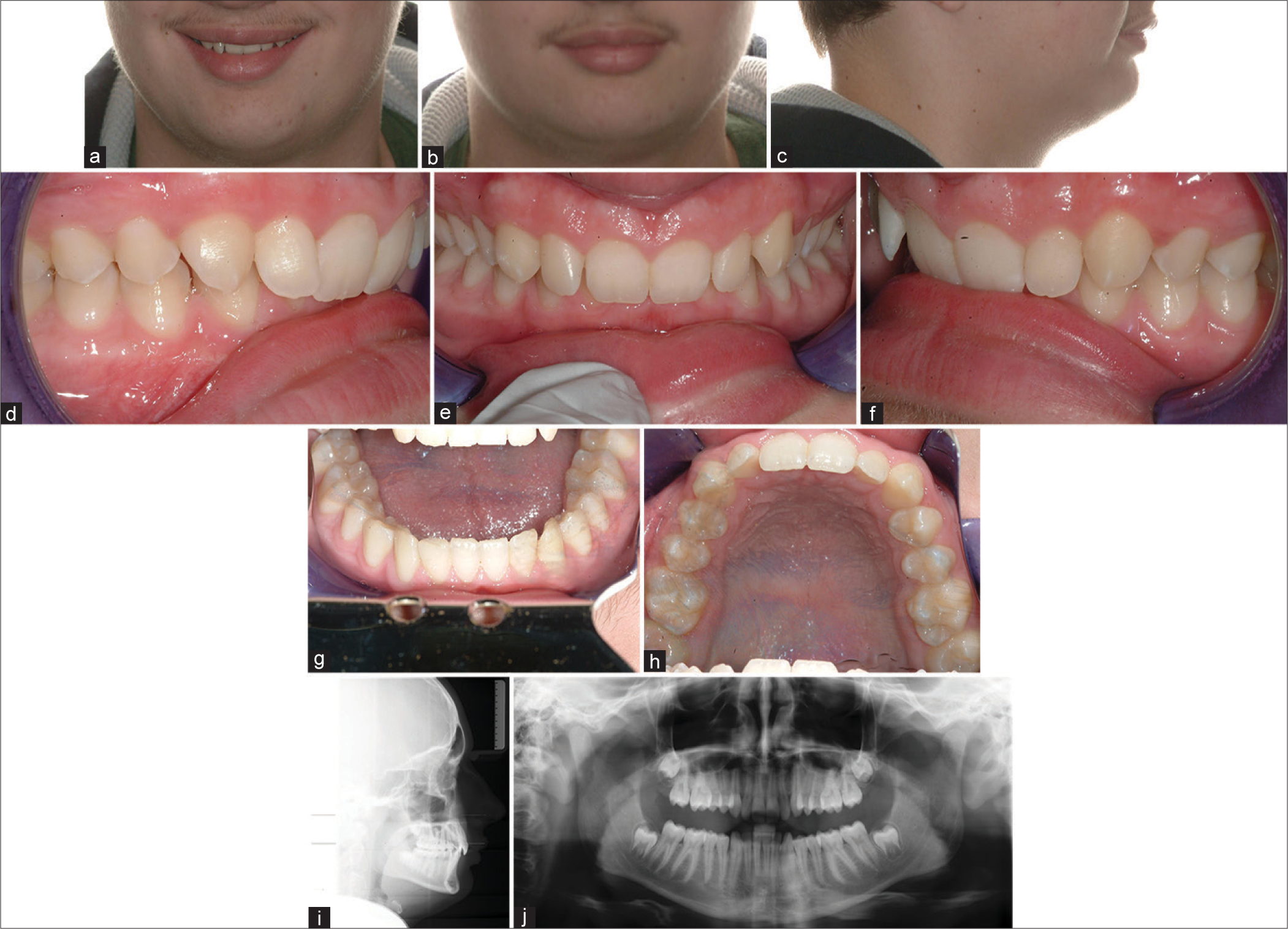
- TC consult. (a) Facial front smiling. (b) Facial front. (c) Facial profile. (d) Intraoral right. (e) Intraoral center. (f) Intraoral left. (g) Occlusal lower. (h) Occlusal upper. (i) X-ray lateral. (j) X-ray panoramic

- Pre treatment
My treatment plan was to utilize the AdvanSync 2 appliance to correct the Class II, advancing the mandible to improve his facial balance. I incorporated the Damon System braces to correct the torque of the maxillary incisors and correct the overbite.
On the initial appointment, I placed the AdvanSync 2 crowns on the first molars and bracketed the rest of the teeth anterior to the crowns. I placed 0.014” CuNiTi wires to begin the leveling process. I also placed an overlay 0.016” × 0.025” stainless steel wire in the lower arch to aid in the leveling of the lower arch.
Three months after treatment, I placed the AdvanSync 2 arms [Figure 3]. I needed to level the lower arch and torque the upper incisors labially before placing the arms. If I had not done this, the patient would have been positioned in an end-on incisor relationship, creating a large posterior open bite. This leads to the arms orienting themselves into a more vertical position and not correcting the Class II.
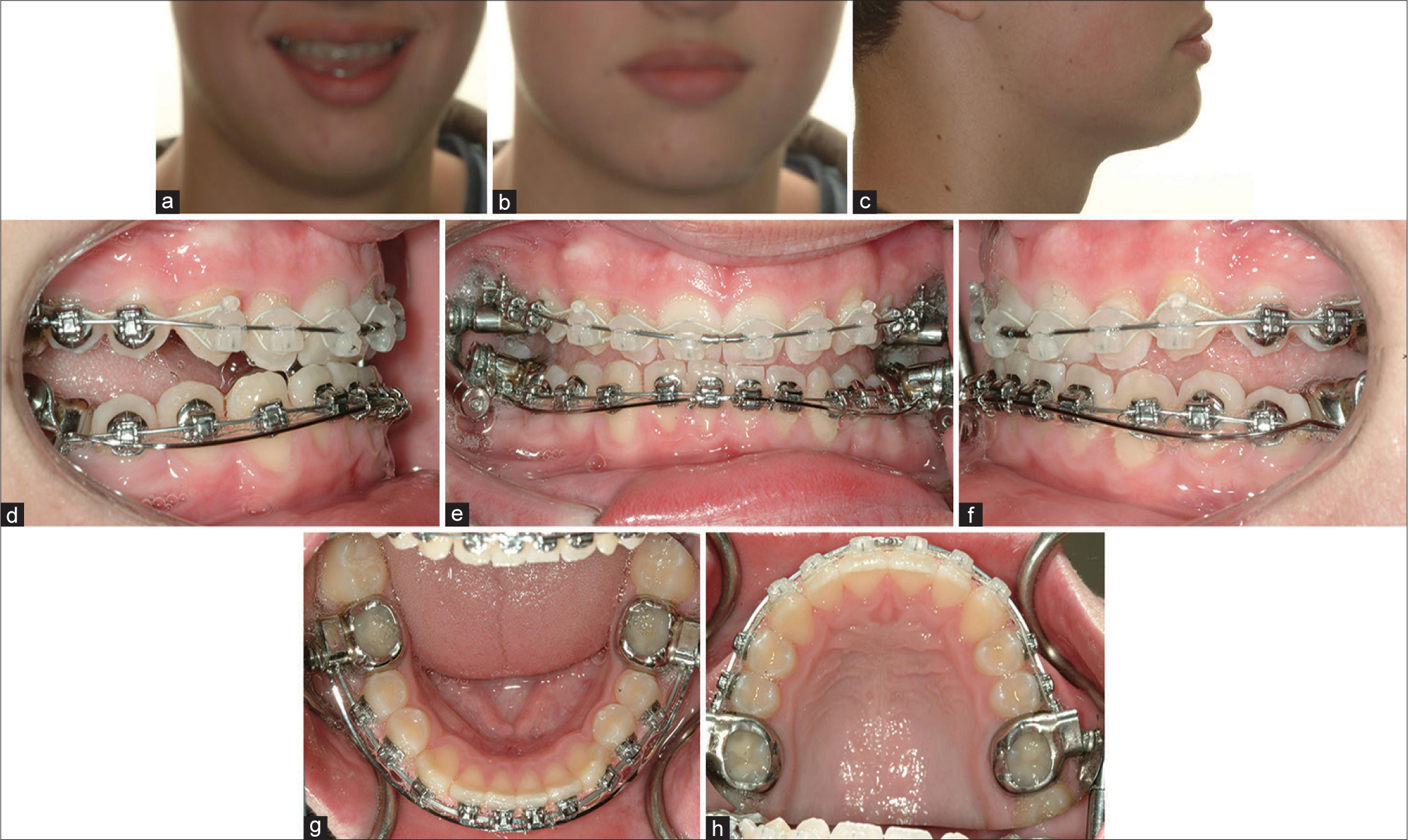
- Hooked up herbst. (a) Facial front smiling. (b) Facial front. (c) Facial profile. (d) Intraoral right. (e) Intraoral center. (f) Intraoral left. (g) Occlusal lower. (h) Occlusal upper
Make sure to always evaluate this before attaching the arms. If the arms get oriented in a more vertical position rather than horizontal, then remove the arms and continue the leveling and aligning until the proper overbite has been established and there is an adequate overjet to advance the mandible.
The patient had the AdvanSync 2 appliance for 7 months at which time we removed the appliance while the mandible was in an overcorrected position [Figure 4]. The patient was in treatment for 16 months with 12 appointments. As you can see in the photos in Figures 1 and 5, the patient had a complete transformation facially from the skeletal correction we achieved using the AdvanSync 2 appliance [Figures 2, 6 and 7].
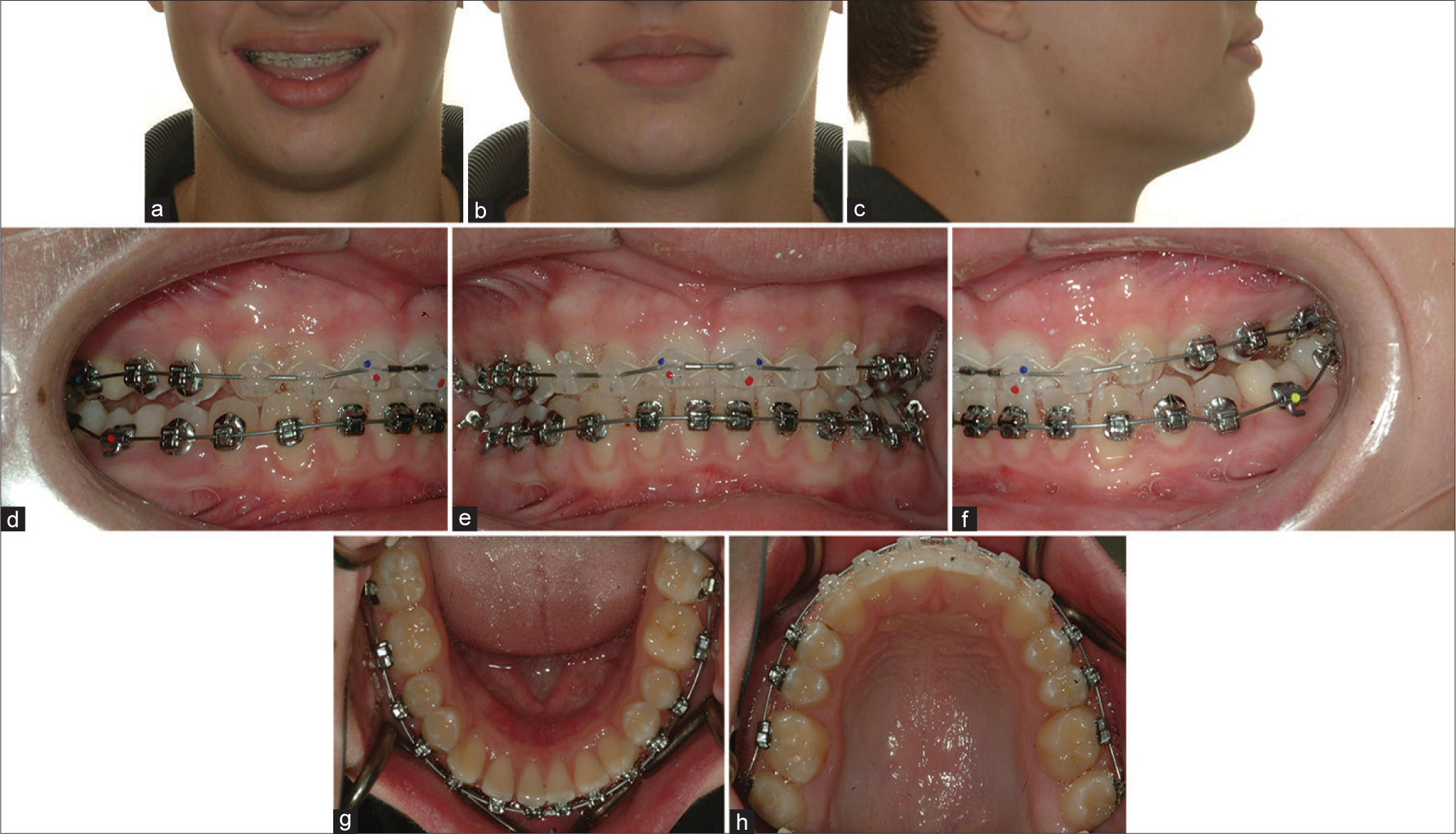
- Progress. (a) Facial front smiling. (b) Facial Front. (c) Facial profile. (d) Intraoral right. (e) Intraoral center. (f) Intraoral left. (g) Occlusal lower. (h) Occlusal upper
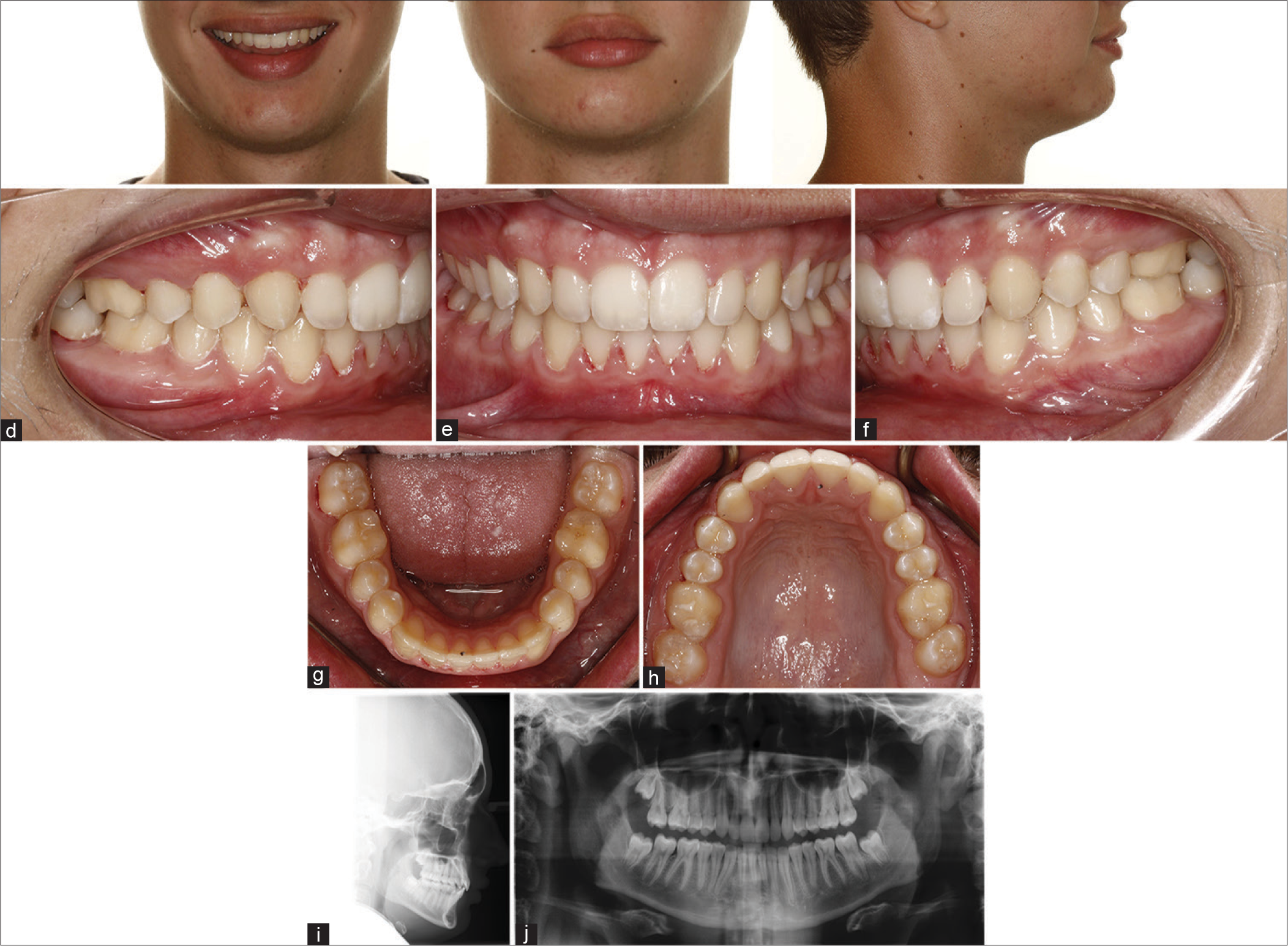
- Final. (a) Facial front smiling. (b) Facial front. (c) Facial profile. (d) Intraoral right. (e) Intraoral center. (f) Intraoral left. (g) Occlusal lower. (h) Occlusal upper. (i) X-ray lateral. (j) X-ray panoramic
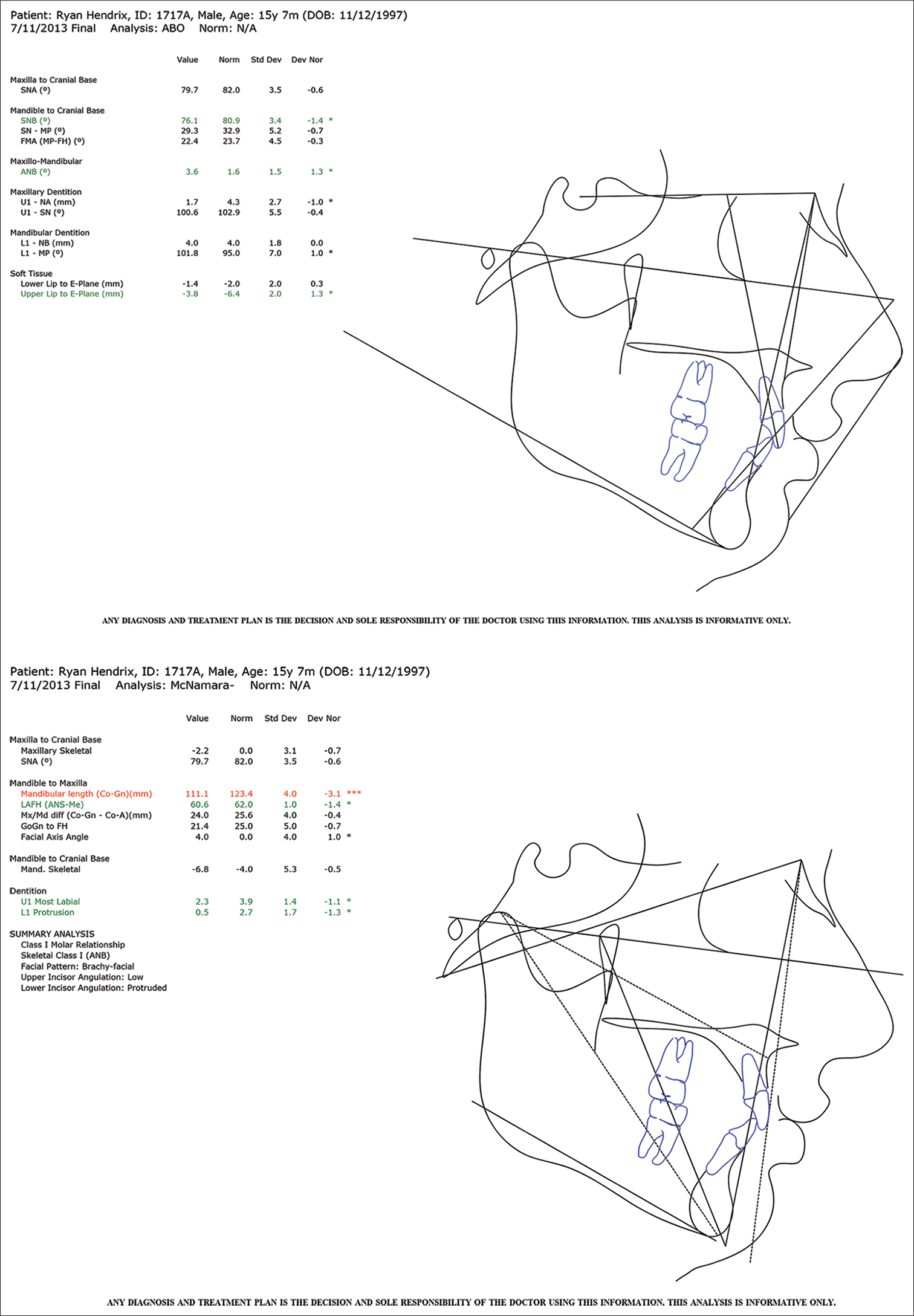
- Post treatment
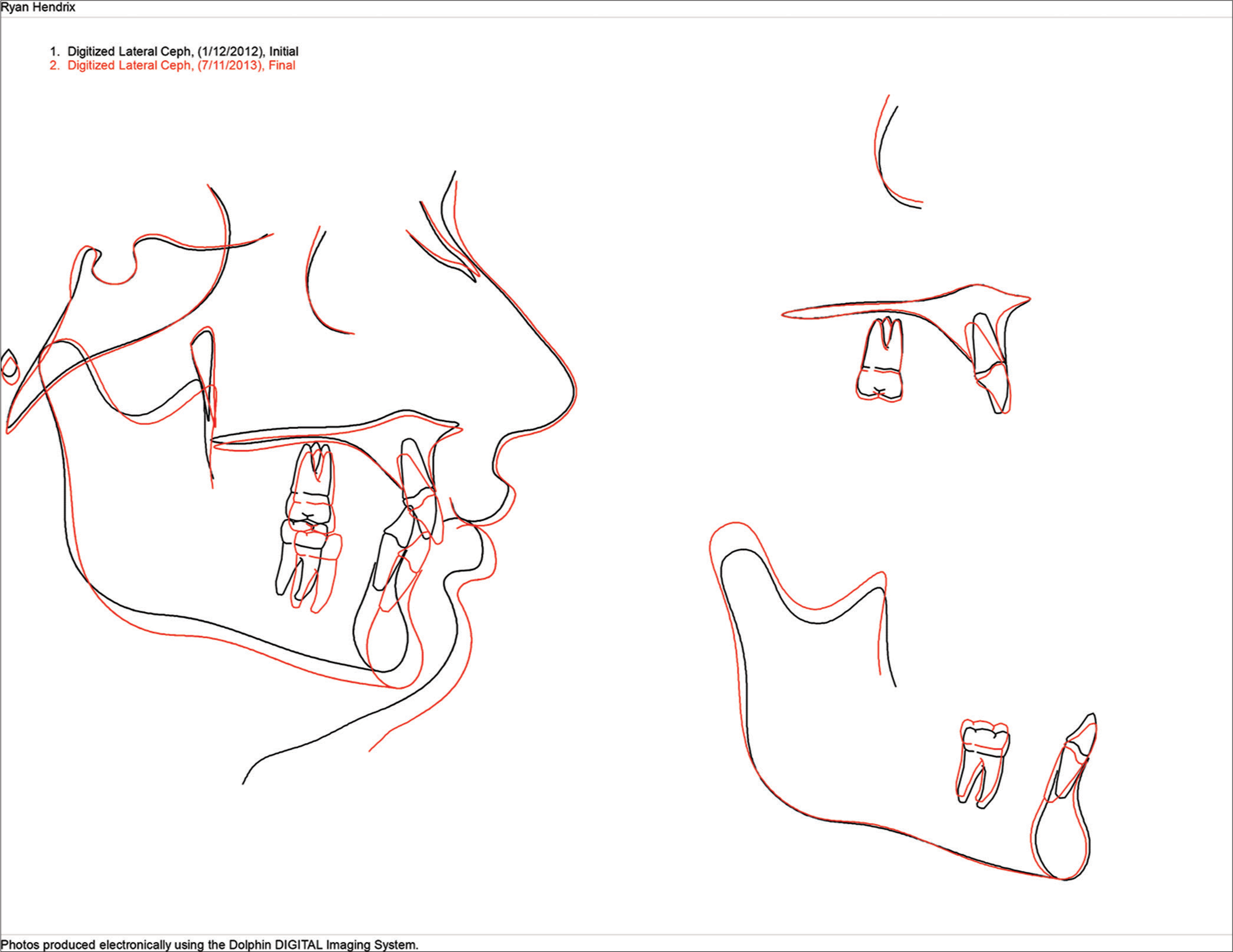
- Superimposition
Since my father Terry had begun using the Herbst appliance in 1981 and since starting my orthodontic career 20 years ago, I have seen a great progression in the comfort and efficiency of treating skeletal Class II patients. It has been so rewarding to see my patients go through a better experience than what was previously available with Herbst appliances.
Declaration of patient consent
The authors certify that they have obtained all appropriate patient consent forms. In the form the patient(s) has/have given his/her/their consent for his/her/their images and other clinical information to be reported in the journal. The patients understand that their names and initials will not be published and due efforts will be made to conceal their identity, but anonymity cannot be guaranteed.
Financial support and sponsorship
Nil.
Conflicts of interest
There are no conflicts of interest.
References
- Histologic analysis of temporomandibular joint adaptation to protrusive function in young adult rhesus monkeys (Macaca mulatta) Am J Orthod. 1982;82:288-98.
- [Google Scholar]
- Temporal bone adaptations in response to protrusive function in Juvenile and young adult rhesus monkeys (Macaca mulatta) Eur J Orthod. 1984;6:155-74.
- [Google Scholar]
- The mechanism of class II correction in Herbst appliance treatment. A cephalometric investigation. Am J Orthod. 1982;82:104-13.
- [Google Scholar]
- Dentofacial orthopedics in relation to somatic maturation. An analysis of 70 consecutive cases treated with the Herbst appliance. Am J Orthod. 1985;88:273-87.
- [Google Scholar]
- A comparison of the Herbst and Fränkel appliances in the treatment of class II malocclusion. Am J Orthod Dentofacial Orthop. 1990;98:134-44.
- [Google Scholar]
- A comparison of the MARA and the AdvanSync functional appliances in the treatment of class II malocclusion. Angle Orthod. 2012;82:907-14.
- [Google Scholar]
- Stability of class II treatment with an edgewise crowned Herbst appliance in the early mixed dentition: Skeletal and dental changes. Am J Orthod Dentofacial Orthop. 2011;140:210-23.
- [Google Scholar]
- Condyle/glenoid fossa changes of class II patients treated with the edgewise crowned Herbst appliance in the early mixed dentition period. Hong Kong Dent J. 2011;8:9-17.
- [Google Scholar]





